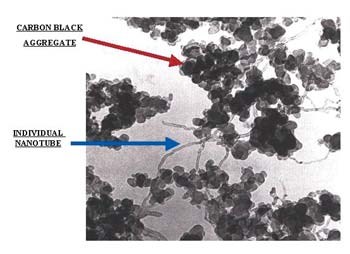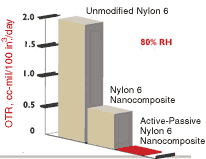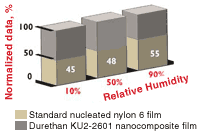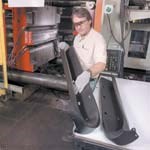Nanocomposites Broaden Roles in Automotive, Barrier Packaging
Nanocomposites are gradually gaining acceptance in the mainstream of global plastics processing. These polymer compounds, containing relatively low loadings (under 6% by weight) of nanometer-sized mineral particles, are beginning to show up in polypropylene and TPO-based automotive exterior claddings, barrier beer bottles, nylon packaging films, polyethylene pipe and wire/cable coatings, and more.
Nanocomposites are gradually gaining acceptance in the mainstream of global plastics processing. These polymer compounds, containing relatively low loadings (under 6% by weight) of nanometer-sized mineral particles, are beginning to show up in polypropylene and TPO-based automotive exterior claddings (see sidebar), barrier beer bottles, nylon packaging films, polyethylene pipe and wire/cable coatings, and more.
Optimism surrounding these novel materials has increased since they burst into industry consciousness two or three years ago. Exploratory effort has intensified as a growing body of data substantiates the potential of established nylon/clay nanocomposites, emerging polyolefin versions, and a range of other resin matrixes and nano-fillers (see Table 1).
Real-world applications are coming more slowly, in part because of the need to validate cost-effectiveness in the face of high price tags for nano-particle ingredients. Some early application-development programs have lapsed for cost reasons. Such casualties include an automotive timing-belt cover based on a nylon 6 nanocomposite from Japan's Unitika and an automotive mirror housing of conductive PPO/nylon alloy from GE Plastics.
Yet the promise of nanocomposites is undiminished. They can improve polymers' stiffness, HDT, dimensional stability, gas barrier, electrical conductivity, and flame retardancy. Nano-particles are so small and their aspect ratio (L/D) so high that properties improve with lower loadings and fewer penalties (such as higher density, brittleness, or loss of clarity) than with conventional reinforcers like talc or glass.
Nano-clays are believed to increase barrier properties by creating a maze or "tortuous path" that slows the progress of gas molecules through the matrix resin. At the same time, these nano-platelets are only 1 nm thick, less than the wavelength of light, so they do not impede light's passage.
As shown in Table 1, nanocomposites now draw on a wider menu of resin matrices, including PP, TPO, EVA, acetal, polycarbonate, biodegradable polylactic acid (PLA), and inherently conductive polyaniline. The nano-particles most widely used so far in these compounds are clays supplied by Nanocor and Southern Clay Products. But a new generation of emerging nano-materials—including nanostructured silicas, carbon nano-tubes, and ceramic nano-fibers—suggest that impressive gains in nanocomposite performance lie just a few years ahead.
New focus on nano-PP
"Progress has moved beyond nylon 6/clay composites to include products based on PP and PE," declares Nanocor president Peter Maul. Nanocor's data show up to 98% stiffness improvement in PP and up to 52° F higher HDT (Table 2). The company says the nanocomposite has virtually the same impact strength as unfilled PP homopolymer.
General Motors recently announced the first-ever automotive production part in an olefinic nanocomposite. It's an exterior step assist for 2002 vans, made of a nano-clay/TPO compound from Basell. William Windscheif, Basell's global business v.p. for advanced polyolefins, calls this application "a small step, but a giant one for nanocomposites," adding that it heralds a broader shift to nano-PP in automotive.
Initially, the auto industry expressed most interest in nylon 6 nanocomposites for use under the hood, where higher HDT and lightweighting were the goals. Ingolf Buethe, senior v.p. for polymer research at BASF in Germany, says nylon nanocomposites show considerable promise in terms of enhanced stiffness, heat resistance, and gloss. But a serious downside for a 5%-nano-clay nylon compound tested by BASF was a loss of toughness more pronounced than with standard fillers.
More recently, automotive OEMs and molders have turned their attention to PP and TPO nanocomposites. These polyolefin materials potentially offer engineering-thermoplastic properties at 20% lower density and 50% lower cost per pound.
Consultant Kenneth Sinclair, head of STA Research in Snohomish, Wash., says the auto makers find that combination difficult to ignore. He estimates that about 30% of nano-PP usage by 2004 will be in autos, mostly cannibalizing existing PP applications. But replacement of metals and engineering thermoplastics will follow.
Sinclair says nano-PPs are stiffer and process better than standard PPs, so thin-walling of parts by around 40% is feasible. In turn, thin-walling permits around 25% reduction in cycle times, for 60-80% total savings per part.
Nonetheless, an official at one of GM's domestic competitors insists that car companies will balk at paying a premium for new materials. Nanocor, concluding that automotive OEMs want lighter parts at no extra cost, has focused its attention on non-automotive uses, including pallets, electronics, and appliance housings.
Volvo Corp. of Sweden has studied 5%-nano-clay composites based on a Basell TPO modified with maleic anhydride as a coupling agent. Volvo observed 32% to 50% higher stiffness than 20% talc-filled PP. Impact strength was lower than unmodified TPO but higher than 20% talc-filled TPO. Volvo found that nano-TPO still has 68% lower stiffness than aluminum sheet.
A long-term goal for Dow Plastics is in-reactor compounding of nano-PP by using nano-clays as the catalyst support for in-situ polymerization of PP homopolymer. Dow's effort is focused on highly loaded (up to 10% clay) nano-PPs for semi-structural automotive uses. Dow sources say preliminary findings show "quite promising" performance of these composites.
Nanocor has developed a 40-50% nano-clay concentrate in PP. One potential use is in heavy-duty electrical enclosures that must meet various fire ratings plus demanding specs for low-temperature toughness and weatherability. Switching to nano-PPs could bring 18% weight savings and permit use of less halogenated FR additive to reach a given UL rating.
In other polyolefins, Kabelwerk Eupen of Belgium says melt blending of nano-clay into EVA shows promise for wire and cable compounds. Calorimeter tests reveal a dramatic decline in heat release at relatively low (3-5%) loadings. Nano-EVAs also exhibit superior mechanical properties, chemical resistance, and thermal stability.
Meanwhile, not all automotive work in nanocomposites involves polyolefins. A role for nanocomposites in polycarbonate automotive glazing is being explored by Exatec of Wixom, Mich., the joint venture of Bayer and GE Plastics that is dedicated to PC auto-glazing development. Exatec marketing director Fritz Stein says nano-technology is being considered for the exterior coating needed to achieve weatherability and abrasion-resistance without reducing clarity. A Bayer coating containing nano-particles is one of several promising approaches being pursued, Stein reports.
Advances in packaging
The major application focus for nylon 6 nanocomposites today is in high-barrier packaging. Much of the attention is on PET bottles, where nanocomposites demonstrate improved oxygen and carbon dioxide barrier. Honeywell offers a 2%-nano-clay nylon 6 for bottles and has a 4%-nano-clay version in development. An early commercial use is a pasteurizable beer bottle that will be introduced in China later this year.
Nano-clays also enhance the oxygen barrier and stiffness of nylon 6 films. That could permit downgauging of packaging of oxygen-sensitive products—pet foods, boil-in bags, vacuum packs, and stand-up pouches. No modification of cast film equipment is needed.
"Nano-clays significantly boost the barrier performance of nylon 6 while retaining most of its existing favorable characteristics," states Lance Altizer, Honeywell's market-development manager. He notes that nanocomposites retain nylon's toughness, clarity, hot-fill heat resistance, and oil/grease resistance. Honeywell claims that nylon 6 with 2% nano-clay has three times the oxygen barrier of straight nylon 6, and 4% nano-clay confers a six-fold improvement. That makes Honeywell's Aegis NC nano-nylon a candidate for medium-barrier bottles and films—those offering around 0.5 to 1 cc/mil/day O2 transmission rate (OTR). Data also show a doubling of stiffness, higher HDT, and improved clarity for nano-nylon 6 packaging.
Honeywell has turned its attention to creating nano-nylon materials that can beat the cost of high-barrier plastics or even glass. Its current contender is an active-passive barrier system called Aegis OX, which synergizes nano-clays as the passive barrier and a proprietary, nylon-specific oxygen scavenger as the active agent.
Honeywell claims this one-two punch brings a 100-fold reduction in OTR versus nylon 6, taking oxygen ingress to near-zero levels (Fig. 1). It also addresses a drawback of existing O2 scavengers: In the Honeywell system, the passive barrier protects the scavenger from premature depletion. Efficiency of the system is also improved by uniform dispersion of the nano-platelets and by ensuring that the scavenger is positioned "to easily find the oxygen," as a Honeywell source puts it.
Aegis materials are being tested by major PET bottle makers. Honeywell says nano-nylon 6 tends to stretch and orient in ways compatible with stretch-blow molding processes. Current barrier requirements for beer bottles (in which Aegis OX would be the core of a three-layer structure) set a maximum limit on oxygen ingress over 120 days, as well as a limit of 10% CO2 escape in that time. The beer industry appears headed toward a 180-day barrier standard for both gases.
"We feel Aegis OX will compete against any existing barrier system for beer," says Honeywell's Altizer. He claims that Aegis OX meets both 120-day requirements and that the 180-day standard is achievable with processing refinements.
Nanocor has come up with a different high-barrier option. Its Imperm compound supplements the inherent gas barrier (0.35 cc/mil/day) of amorphous MDX6 nylon from Mitsubishi Gas Chemical with the addition of a nano-clay. Used as the core of a three-layer PET bottle, Imperm is said to have 100-fold lower OTR than that of straight PET. It is being used in a 16-oz, non-pasteurized beer bottle in which the Imperm core (10% of bottle thickness) reportedly ensures a 28.5-week shelf life. Imperm is said to adhere to PET without tie layers. Sufficient clarity is retained to meet requirements for the amber bottle.
Bayer is aiming nylon 6 nanocomposites at cast film for multi-layer packaging, protective films for medical and corrosion-prone items, and more. Bayer's pre-commercial Durethan KU2-2601 compound uses Nanocor's clay to reduce OTR by around 50% versus nucleated nylon 6 (Fig. 2). Stiffness of the nanocomposite is doubled, and its gloss and clarity rival those of a costly high-clarity copolyamide film, Bayer reports. Anti-blocking properties are also improved.
Meanwhile, nanocomposites also limit emissions of gasoline, methanol, and organic solvents. Ube America is developing nanocomposite barriers for automotive fuel systems. It uses up to 5% nano-clay in nylon 6 and 6/66 blends. Nylon 6 with 2% nano-clay is said to be five times more resistant to gasoline permeation than unmodified nylon 6. Ube has developed a coextruded barrier fuel line, trade-named Ecobesta, using nylon 6/66 nanocomposite as the core layer.
New spark in conductivity
Suppliers of various nano-chemicals, nano-fibers, and nano-tubes argue that the potential of their technologies exceeds that of current nano-clay materials. But the prices are prohibitively high, and practical impacts probably lie five years ahead.
Static-dissipative applications are emerging as one potentially large market. Applied Sciences has developed a vapor-grown carbon nano-tube made by pyrolysis of coal. Pyrograf-III comes in 100- and 200-nm diam. and has potential as an electrically conductive additive and modifier of plastics' coefficient of thermal expansion.
Max Lake, president of Applied Sciences, says the nano-tubes enhance electrical conductivity over a broad resistivity range and boost mechanical properties. Just 0.5% loading provides volume resistivity in the 104 ohm-cm range.
Another class of nano-tube is a graphitic carbon type that is designed primarily to enhance electrical conductivity. These nano-tubes or "fibrils" are made from a hydrocarbon gas by Hyperion Catalysis International. They offer surface resistivity of 103 to 105 ohm/sq at 4% to 7% loadings.
"Fibrils are more efficient at building electrical conductivity into plastics than carbon black or PAN carbon fibers," states John Hagerstrom, Hyperion's technical service manager. He says the fibrils' small diameter (10 nm average) and high aspect ratio (1000:1) mean a given level of conductivity is achieved at lower loadings than with conventional carbon particles or fibers. That reportedly means less sacrifice of matrix properties, lower warpage, and better surface smoothness. Fibrils have been used to enhance electro-static painting of automotive mirrors, and as a static-dissipative additive in semiconductor components and disk drives, where the non-sloughing feature of nano-tubes helps retain purity.
Hybrid Plastics offers "POSS" nano-chemicals, named for their polyhedral oligomeric silsesquioxane molecular building blocks. These molecular silicas are hybrid organic-inorganic materials said to bridge conventional differences between minerals and monomers.
POSS molecules are cage-like structures typically measuring 1.5 nm along each axis. "The single-molecule particles are truly dispersable and have no affinity for one another," says Joseph Lichtenhan, Hybrid's president. Even loadings of 50% or more by weight reportedly disperse without agglomeration. POSS molecules dissolve in a plastic melt, then recrystallize on cooling into a network that enhances mechanical and thermal properties, as well as flame-retardancy.
"These chemical tools allow the creation of superior reinforced, crosslinked, and chemically coupled alloys," Lichtenhan claims. A 10% POSS loading elevates PP's flexural modulus by 12%, HDT by 21%, and impact strength by 36%. A 50% POSS loading in crystal PS reportedly has no effect on optical clarity. Hybrid cites optical disks, micro-electronics, and medical products as target niches. At present, POSS costs around $200/lb. A larger plant for making POSS nano-chemicals, due on-line in early 2002, could push down the cost of some POSS products to about $15/lb. Hybrid Plastics' sales and marketing arm is Divex, Inc.
Argonide has a technology for producing alumina ceramic nano-whiskers by electro-explosion of metal wire. These NanoCeram whiskers offer potential for reinforcement because of their small size (2 nm diam.) and high aspect ratio (50:1 average). Applications for NanoCeram are being pursued as reinforcements and thermally conductive additives. Current price of pilot-plant materials is $280/lb, but that is likely to fall as usage develops.
Table 1—Partial Listing of Nanocomposite Suppliers Supplier & Tradename Matrix Resin Nano-Filler Target Market Bayer AG
(Durethan LPDU)Nylon 6 Organo-clay Barrier films Clariant PP Organo-clay Packaging Creanova
(Vestamid)Nylon 12 Nano-tubes Electrically conductive GE Plastics
(Noryl GTX)PPO/Nylon Nano-tube Automotive painted parts Honeywell
(Aegis)Nylon 6
Barrier NylonOrgano-clay
Organo-clayMulti-purpose
Bottles and filmHyperion PETG, PBT
PPS, PC, PPNano-tube Electrically conductive Kabelwerk Eupen of Belgium EVA Organo-clay Wire & cable Nanocor
(Imperm)Nylon 6
PP
Nylon MDX6Organo-clay
Organo-clay
Organo-clayMulti-purpose
Molding
PET beer bottlesPolymeric Supply Unsaturated polyester Organo-clay Marine, transportation RTP Nylon 6, PP Organo-clay Multi-purpose, electrically conductive Showa Denko
(Systemer)Nylon 6
AcetalClay, mica
Clay, micaFlame retardance
Multi-purposeUbe
(Ecobesta)Nylon 6, 12
Nylon 6, 66Organo-clay
Organo-clayMulti-purpose
Auto fuel systemsUnitika Nylon 6 Organo-clay Multi-purpose Yantai Haili Ind. & Commerce of China UHMWPE Organo-clay Earthquake-resistant pipe Source: Bins & Associates, Sheyboygan, Wis.
Table 2— Effect Of 6% Nano-Clay On PP Homopolymer Properties PP Type, MFR Flexural Modulus, psi Heat Deflection Temp., F Unmodified Nano-PP Unmodified Nano-PP Conventional
4 g/10 min166,000 296,000 189 241 Conventional
14 g/10 min173,000 258,000 187 228 Nucleated
35 g/10 min231,000 335,000 235 250 Source: Nanocor
Related Content
Shredding Thin Film: How to Do It Right
While many processors recoil at this task, a little know-how in shredding equipment, processing, and maintenance should add the necessary confidence.
Read MoreUnderstanding Melting in Single-Screw Extruders
You can better visualize the melting process by “flipping” the observation point so the barrel appears to be turning clockwise around a stationary screw.
Read MoreWhat to Know About Your Materials When Choosing a Feeder
Feeder performance is crucial to operating extrusion and compounding lines. And consistent, reliable feeding depends in large part on selecting a feeder compatible with the materials and additives you intend to process. Follow these tips to analyze your feeder requirements.
Read MoreThe Role Barrel Temperatures Play in Melting
You need to understand the basics of how plastic melts in an extruder to properly set your process and troubleshoot any issues. Hint: it’s not about the barrel temperature settings.
Read MoreRead Next
Beyond Prototypes: 8 Ways the Plastics Industry Is Using 3D Printing
Plastics processors are finding applications for 3D printing around the plant and across the supply chain. Here are 8 examples to look for at NPE2024.
Read MorePeople 4.0 – How to Get Buy-In from Your Staff for Industry 4.0 Systems
Implementing a production monitoring system as the foundation of a ‘smart factory’ is about integrating people with new technology as much as it is about integrating machines and computers. Here are tips from a company that has gone through the process.
Read More
























